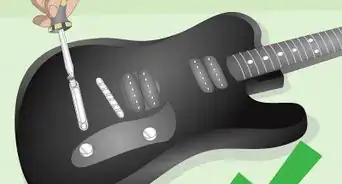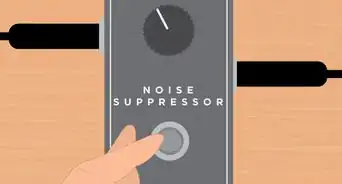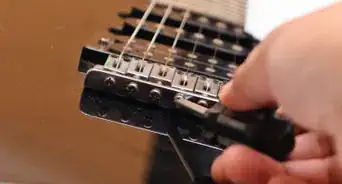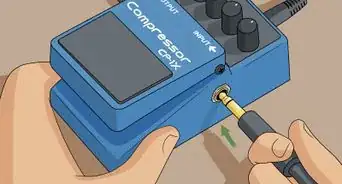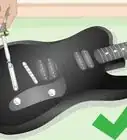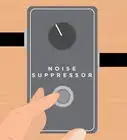This article was co-authored by Aaron Asghari and by wikiHow staff writer, Jennifer Mueller, JD. Aaron Asghari is a Professional Guitarist and the lead guitarist of The Ghost Next Door. He received his degree in Guitar Performance from the Guitar Institute of Technology program in Los Angeles. In addition to writing and performing with The Ghost Next Door, he is the founder and primary guitar instructor of Asghari Guitar Lessons.
This article has been viewed 168,704 times.
The design of the floating bridge, or Floyd Rose bridge, enables you to incorporate various effects in your playing style without knocking the strings out of tune. The process of restringing a guitar with a floating bridge is a little more complicated than restringing any other guitar. However, once you get the hang of it, you'll be able to do it without any problems.[1]
Steps
Removing Old Strings
-
1Place your guitar on a flat, clean surface. Lay down a towel or soft cloth on your table or counter to protect your guitar's body from scratches. If you have a headstand, you can use that to hold the neck for added stability.
- Set up your work station by laying out your tools. You'll need Allen wrenches for the nut plates and saddle, wire cutters, and a string winder. You may also want to gather cleaning supplies so you can clean your guitar after removing the old string.
-
2Take off the locking nut plates using an Allen wrench. The locking nut plates hold the strings in place. Turn your Allen wrench slowly to loosen the plates before removing them. Put the plates in a safe place so you don't lose them.[2]
- Your guitar likely came with a set of Allen wrenches designed specifically for this use. If not, you can find a set at most music or guitar shops, or you can order one online.
Advertisement -
3Unwind the string at the tuning peg. Turn the tuning peg slowly to release tension in the string before taking it out. If you need to remove multiple strings, only remove and replace one string at a time. If you take all of them off, your bridge may not have the same tension when you replace them, and you'll have a hard time tuning your guitar.[3]
- A string winder will make this process faster and smoother. If you don't have a string winder, you can turn the tuning peg with your fingers.
- If the string is broken, hold the broken end as you turn the tuning peg. This will unwind the top of the string and keep the broken end from getting tangled in the other strings.
-
4Pull the string out of the peg. When you've unwound the string completely, carefully pull the string to remove it completely from the tuning peg. Take care not to poke yourself with the sharp end of the string.[4]
- If the string isn't broken, you may want to stick the sharp end in an eraser or wrap some tape around it. That way you won't have to worry about it poking or scratching you as you work.
-
5Loosen the saddle with an Allen wrench. Don't loosen all the saddles, only the one that corresponds to the string you want to remove. There is a small metal block in the bridge that keeps the string tight. Keep an eye out for it as you loosen the saddle.[5]
- If the block does come out, put it somewhere safe so you don't lose it. You'll have to put it back in when you replace the string.
- It can help to count the number of turns you made with the Allen wrench to loosen the bridge. You can use that number when you tighten it back up to avoid over-tightening it.
-
6Pull the other end of the string out of the bridge. Wrap the string into a neat coil. If the string was broken, you'll have 2 coils of string. Twist the sharp ends around and dispose of the string safely.[6]
- You may want to wrap tape around the sharp ends to hold the coil together and keep the sharp points from coming loose.
-
7Clean your fretboard with an oil soap or fretboard cleaner. While a string is off, take the opportunity to clean the fretboard beneath it. Use a soft, lint-free cloth to gently rub the cleaner into the wood. Avoid getting the cleaner on any of the other strings.
- You can also polish the frets using the same oil soap. Once you're done cleaning, wipe away any excess with a dry paper towel.
Replacing the Strings
-
1Buy replacement strings of the same gauge. If you don't know what gauge your old strings are, take your guitar into a music shop and have a tech look at them. If you look for your guitar on a string package, that only tells you that those strings are appropriate for your guitar. There's no guarantee those were the strings you had.[7]
- If you want to use a different gauge, you'll need to replace all of your strings, not just the one that's broken. Changing the gauge of your strings will alter the balance between the nut and the bridge, which can destroy your guitar's intonation. Talk to a guitar repair expert before you attempt to do this on your own.
-
2Use wire cutters to snip off the ball end of the replacement string. The ball end of standard guitar strings won't fit in a Floyd Rose bridge. Cut off the ball end as well as the part of the string just above the ball that is tightly twisted. Make sure your cut is even and clean.[8]
- If you're changing more than one string, only cut the ball end off of one string at a time. Since the ball ends are color-coded, this is the only way to know for sure which string is next (unless you're really familiar with the thickness of the strings).
-
3Secure the new string at the bridge. Insert the string into the saddle at the bridge, then tighten the bridge with your Allen wrench. If the small metal block fell out when you loosened the saddle, set it back into place before tightening the bridge.[9]
- Take care not to over-tighten the bridge, or you could damage your guitar. If you counted turns when you loosened it, use the same number of turns to tighten it back up.
-
4Insert the other end of the string in the tuning post hole. Pull the string up the neck of your guitar, making sure it runs over the correct nut slot. Put the end through the post hole and kink the string over itself to lock it in place.
- Line up your postholes with the nut, so you can slide the string straight through to the other side.
- Leave some slack so the string can wrap around the post several times. This will help keep the string from slipping.
-
5Wrap the string around the tuning post. Using your string winder or your fingers, carefully turn the tuning peg to bring the string back to tension. Be careful not to wind it too tight, or the string may snap.
- Each new wrap of the string should be below the previous wrap. This also helps keep your strings from slipping out of tune.
- Bring the string slightly up to tension, but don't try to tune it until you've checked the bridge.
-
6Adjust the bridge if you're changing to a different gauge of strings. Open the back of your guitar with a Phillip's head screwdriver to access the bridge's springs. Slowly adjust the tension on the springs until the bridge is level again.[10]
- A heavier gauge string will cause your bridge to lean forward, while a lighter gauge string causes it to sink back. This can badly affect your guitar's playability. If the bridge is tilted forward, turn the claw screws clockwise to tighten the springs. If the bridge is tilted backward, turn the claw screws counterclockwise to loosen them.
- Turn the screwdriver a quarter-turn at a time, and then check to see whether it's even. You don't want to go too far in the opposite direction.
Retuning Your Guitar
-
1Tune your guitar. Start from the sixth string and move to the first, getting your guitar in tune. Once it's in tune, check the position of the bridge again and make sure it's still parallel to the body of the guitar.
- If the bridge is tilting forward or backward, adjust the tension in the springs from the back of your guitar. You'll probably need to tune your guitar again after doing this.
-
2Pull the string gently away from the fretboard to stretch it. Take the new string between your thumb and fingers. Start at the bridge and stretch a few times going down the neck of the guitar. Stretch the string about a finger's thickness away from the fretboard.
- New guitar strings have a hard time staying in tune unless they've been stretched properly. If you skip this step, your new string won't stay in tune.
-
3Retune your guitar after stretching the strings. After stretching new strings, your guitar will be out of tune again. Go back through the process of tuning your guitar using the tuning pegs at the headstock.
- You may want to play a little bit to help break the new strings in as well. After playing, check to make sure they're staying in tune and the bridge is still balanced. Make adjustments as needed.
-
4Set the fine tuners to the middle of their adjustment range. Once your guitar is tuned, turn your fine tuners to the middle. This gives you room to adjust your strings flat or sharp after you've locked the nut.[11]
- Strum your guitar again to make sure it's in tune. Check the balance of the bridge. These small rechecks will help your guitar's new strings stay in tune.
-
5Lock the Floyd Rose nut. Take the locking plates you removed from your guitar and place them back on your guitar. Use the Allen wrench to tighten them back into place. Make sure the strings are all in the appropriate notches.
- Don't over-tighten, but make sure the strings are flattened out again. The locking plates help keep the strings from slipping when you use your whammy bar.
-
6Fine-tune your guitar before playing it. After you've locked the nut, don't touch the tuning pegs at the headstock again. This will snap your string and could damage your guitar. Use the fine tuner knobs at the bridge to bring your guitar up to pitch.[12]
- Check the balance of the bridge again. Make sure it's sitting parallel to the guitar with the strings tuned.
- If your action (space between the strings and the fretboard) is too high or too low, you may also want to make adjustments for that. You can adjust the action by turning the bridge pivot screws or "rocker screws" using an Allen wrench. Adjust slowly, checking after each quarter-turn.
Expert Q&A
- How do you restring a Floyd Rose without strings?
Depending on your bridge, you'll either need to run the strings through the tail of the bridge, or from the back side of the guitar through the tone block. Wrap each string around the appropriate capstan, and use the tuning key to tighten the string to ensure nice, even wraps. For the best results, retune the guitar after each string is replaced.
- How do you restring a floating bridge on a guitar?
String the guitar the same way you normally would. Once you tune the strings, check the bridge to make sure it's floating level. If the bridge is leaned backwards, you'll need to loosen the claw screws in the bridge cavity and retune it. Repeat this process until the bridge sits level. If the bridge is tipped forward, you'll tighten the screws and retune the strings until it's level.
- How does a Floyd Rose bridge work?
A Floyd Rose bridge uses springs in the bridge cavity to counter the force of the strings on the bridge. When it's properly set up, the net force between the two is balanced. Any change in force on one side is then counteracted by an opposing force from the other, which allows the bridge to return to its neutral position.
Community Q&A
-
QuestionHow do I get the correct tone?
 Kathy5421Community AnswerIf you look at the F-holes, you'll see two lines. Try to line up the bridge with the lines to get to right tone.
Kathy5421Community AnswerIf you look at the F-holes, you'll see two lines. Try to line up the bridge with the lines to get to right tone. -
QuestionThe top 3 stings (E, B & G) keep flying out from the saddles when under tension - what am I doing wrong? The guitar has had fret-leveling and re-profiling carried out, and is in the final throes of being rebuilt.
 Community AnswerWhen tightening the strings, hold the strings on the saddle until they are tight enough that they're not going to come off.
Community AnswerWhen tightening the strings, hold the strings on the saddle until they are tight enough that they're not going to come off. -
QuestionWhich way does the bridge go back on an Ibanez acoustic?
 Community AnswerThe bridge of an acoustic should never be removed. If you have done so, contact a professional luthier to repair the instrument, as specific glues and techniques are needed to repair bridges.
Community AnswerThe bridge of an acoustic should never be removed. If you have done so, contact a professional luthier to repair the instrument, as specific glues and techniques are needed to repair bridges.
Things You'll Need
- Fresh pack of strings
- Wire cutters
- Allen wrenches
- String winder
- Phillips-head screwdriver
References
- ↑ https://blog.andertons.co.uk/learn/floyd-rose-guide
- ↑ https://blog.andertons.co.uk/learn/floyd-rose-guide
- ↑ https://blog.andertons.co.uk/learn/floyd-rose-guide
- ↑ https://blog.andertons.co.uk/learn/floyd-rose-guide
- ↑ https://blog.andertons.co.uk/learn/floyd-rose-guide
- ↑ https://blog.andertons.co.uk/learn/floyd-rose-guide
- ↑ https://blog.andertons.co.uk/learn/floyd-rose-guide
- ↑ https://blog.andertons.co.uk/learn/floyd-rose-guide
- ↑ https://blog.andertons.co.uk/learn/floyd-rose-guide
-Step-1-Version-2.webp)
-Step-2-Version-2.webp)
-Step-3-Version-2.webp)
-Step-4-Version-2.webp)
-Step-5-Version-2.webp)
-Step-6-Version-2.webp)
-Step-7-Version-2.webp)
-Step-8-Version-2.webp)
-Step-9-Version-2.webp)
-Step-10-Version-2.webp)
-Step-11-Version-2.webp)
-Step-12-Version-2.webp)
-Step-13-Version-2.webp)
-Step-14-Version-2.webp)
-Step-15-Version-2.webp)
-Step-16-Version-2.webp)
-Step-17-Version-2.webp)
-Step-18-Version-2.webp)
-Step-19-Version-2.webp)

